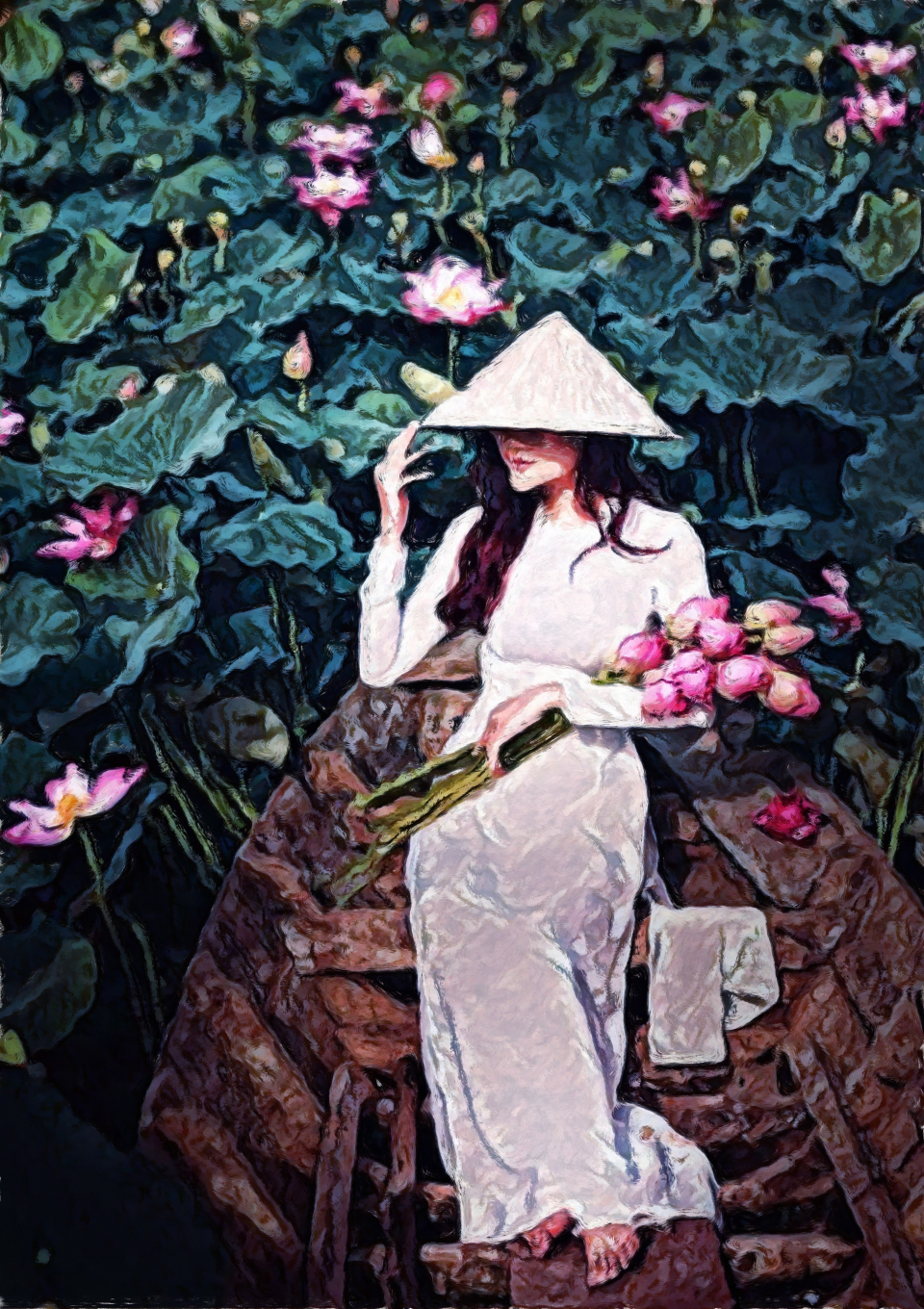世界風情畫「越南最美的服飾-奧黛」浮世繪大師-葛飾北齋 及版畫大師-M·C·艾雪 風格畫作#09

Story
作為越南國服,也是各行各業的制服,
「奧黛」可謂無處不在,
1995年世界小姐選美比賽,贏得最佳民族服飾獎項。
畫作主題:越南最美的服飾-奧黛
「奧黛」(Áo dài)乃越南的國服,是近代越南人和中國京族的服裝。越南語的字面意思是長襖,也被譯為「襖長」、「襖黛」等。 奧黛被譽為越式旗袍l合身裁剪,完美展現了女性的曲線之美。鋪主感覺它和旗袍最大的不同是,它開叉開到了腰上,所以平時還得再穿褲子。不過也因為開叉很高,行、住、坐、躺都非常方便,所以穿上它都能適應各個生活場景。
「奧黛」由上衣和褲子組成,上衣的上半段酷似中國的旗袍,長及腳踝,只是胸部勒緊,兩側腰收緊,從腰部開叉,有一定的收腰效果。上衣的下半段分前後兩片裙襬,走路時前後兩片裙襬隨風而動。「奧黛」裏面配一條白色或是同花色的長達腰際的闊腳長褲,過去「奧黛」的顏色代表了年齡與地區,少女是純潔的白色、未婚女子是柔和的粉色、已婚婦女則是深色,北越女性喜好黃絹色,中越女性偏愛紫檀色,而南越女性則選擇白色或刺繡花樣。
以前「奧黛」只會在重要慶典、會客及婚宴使用,如今越南政府鼓勵婦女在正式場合穿着國服。因此「奧黛」已成越南女性在節慶廟會和日常生活中普遍使用的穿着服飾。春節時普遍穿紅色的,喪禮穿黑色,婚禮以粉色為最佳。大中院校的女子校服定為白色國服,以象徵少女的純潔。
「奧黛」起源於18世紀順化廣南國的宮廷服裝,越南長襖於19世紀和20世紀初演變成五身貴族長袍。受巴黎時裝啟發,阮吉祥和其他藝術家於20世紀20年代到30年代聯合印度支那大學(今河內國家大學)重新設計了五身長袍作為現代服飾,改版款式被藝術家和自力文團推崇為現代國服。50年代,西貢設計師將服裝收緊,製造出現在越南女性穿著的版本。奧黛在越南社會生活中不斷地確立自己的地位,並進入了越南的詩、歌、音樂和繪畫等藝術中,成為了國際友人眼中的越南文化形象的代表。
1989年,越南舉辦「奧黛小姐」的選拔(Miss Ao Dai),有16000越南人蔘加了在胡志明市舉辦的這項選美大賽。此後每年都吸引上千名佳麗參賽,年齡從15歲到35歲都有,而美術學校的學生也開始參與「奧黛」的改良設計,再加上女性雜誌定期發表新的奧黛款式,促使越南紡織業開始蓬勃發展,因而開創越南「奧黛」進入非常繁榮時代。
1995年,東京舉辦世界小姐選美,越南佳麗張瓊梅以一襲藍白相間的錦緞「奧黛」贏得最佳民族服飾獎,同時也引起國際間對「奧黛」的重視。
「奧黛」被譽為越式旗袍,最能突顯女性玲瓏有致的曲線,走路時裙擺隨風飄逸,姿態優雅,在越南街頭隨處可見騎腳踏車和機車穿著奧黛的少女,十分吸引路人的目光,儼然成為越南最美麗、最具代表性的活動漂亮景點。
#世界風情畫「越南最美的服飾-奧黛」採用浮世繪大師-葛飾北齋 (Gold)及藝術版畫大師-莫里茲·柯尼利斯·艾雪 (Life)風格之油彩畫作。
#世界風情畫「越南最美的服飾-奧黛」油彩畫作限量發行 1 個vibe。
As the national uniform of Vietnam, it is also the uniform of all walks of life.
"Aodai" can be said to be everywhere,
Miss World 1995, won the Best National Costume Award.
Theme of the painting: The most beautiful dress in Vietnam - Ao Dai
"Ao dài" (Áo dài) is the national costume of Vietnam, which is the clothing of modern Vietnamese and Chinese Jing people. In Vietnamese, the literal meaning is long jacket, which is also translated as "jacket long", "jacket dai" and so on. Ao Dai is known as the Vietnamese-style cheongsam, which is fitted and tailored, perfectly showing the beauty of women's curves. The shop owner feels that the biggest difference between it and the cheongsam is that it is slit up to the waist, so I usually have to wear pants. However, because the slit is very high, it is very convenient to walk, live, sit, and lie down, so wearing it can adapt to various life scenarios.
"Ao Dai" consists of a top and trousers. The top half of the top is similar to a Chinese cheongsam, reaching to the ankles, but the chest is tightened, the waist on both sides is tightened, and the waist is split, which has a certain waist tightening effect. The lower part of the top is divided into two skirts, front and rear, and the front and rear skirts move with the wind when walking. "Ao Dai" is paired with a pair of white or the same color wide-leg trousers. In the past, the color of "Ao Dai" represented age and region. Girls were pure white, unmarried women were soft pink, and married women were soft pink. Married women are dark, North Vietnamese women prefer yellow silk, Chinese and Vietnamese women prefer red sandalwood, while South Vietnamese women choose white or embroidered patterns.
In the past, "Ao Dai" was only used in important celebrations, guests and wedding banquets. Now the Vietnamese government encourages women to wear national clothes on formal occasions. Therefore, "Ao Dai" has become a common dress worn by Vietnamese women in festivals, temple fairs and daily life. Red is generally worn during the Spring Festival, black is worn for funerals, and pink is the best for weddings. Girls' school uniforms in colleges and universities are set as white national uniforms to symbolize the purity of girls.
"Ao Dai" originated from the court clothing of Quang Nam in Hue in the 18th century, and the Vietnamese tunic evolved into five aristocratic robes in the 19th and early 20th centuries. Inspired by Parisian fashion, Nguyen Siang and other artists collaborated with Indochina University (now Hanoi National University) in the 1920s and 1930s to redesign the five-body robe as a modern dress. Clothes. In the 1950s, Saigon designers tightened the garments to create versions that appeared to be worn by women in Vietnam. Ao Dai has continuously established her position in Vietnamese social life, and has entered into Vietnamese arts such as poetry, song, music and painting, and has become a representative of Vietnamese cultural image in the eyes of international friends.
In 1989, Vietnam held the "Miss Ao Dai" selection (Miss Ao Dai), and 16,000 Vietnamese ginseng joined the beauty contest held in Ho Chi Minh City. Since then, it has attracted thousands of contestants every year, ranging in age from 15 to 35 years old, and art school students have also begun to participate in the improved design of "Ao Dai", coupled with the regular publication of new Ao Dai styles in women's magazines, prompting Vietnam's textile industry began to flourish, thus creating a very prosperous era for Vietnam's "Ao Dai".
In 1995, Tokyo held the Miss World beauty pageant. Vietnamese beauty Zhang Qiongmei won the best national costume award with a blue and white brocade Aodai, which also attracted international attention to Aodai.
"Ao Dai" is known as a Vietnamese-style cheongsam, which can best highlight the exquisite curves of women. When walking, the skirt flows with the wind and has an elegant posture. Girls wearing Ao Dai on bicycles and motorcycles can be seen everywhere in the streets of Vietnam, which is very attractive to passers-by. The eyes have become the most beautiful and representative scenic spots in Vietnam.
#World-style painting "Vietnam's most beautiful costume - Ao Dai" uses oil paintings in the style of Ukiyo-e master - Katsushika Hokusai (Gold) and art print master - Moritz Cornelis Escher (Life).
#World style painting "Vietnam's most beautiful costume - Ao Dai" oil painting limited edition 1 vibe.
Tags
Created on 2022/05/06 15:00:17 UTC
Contract Address
0x74247aE0D95E5be00ED105aFe03Ad0a98f3aEd8F
- Token ID
- 59430
- Chain
- Polygon
- Token Standard
- ERC1155
- Metadata URL
- https://www.oursong.com/project/erc1155token-meta/59430.json


